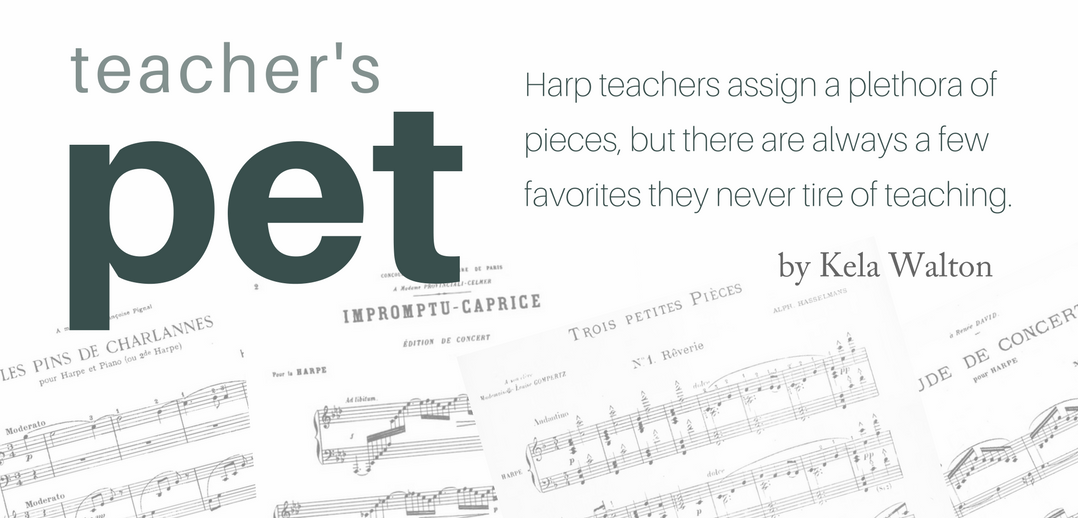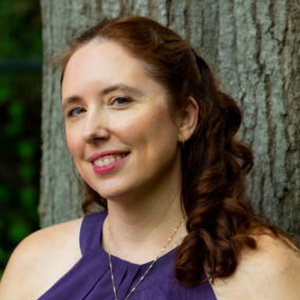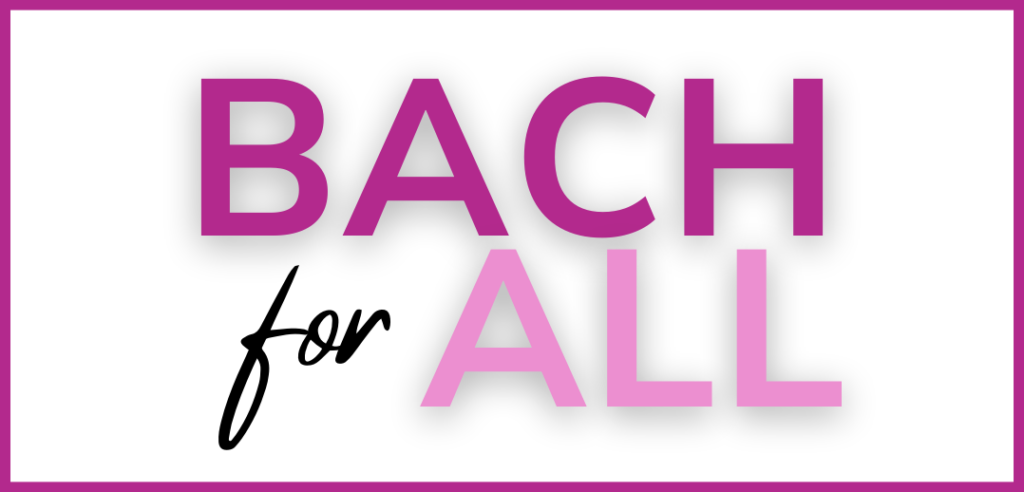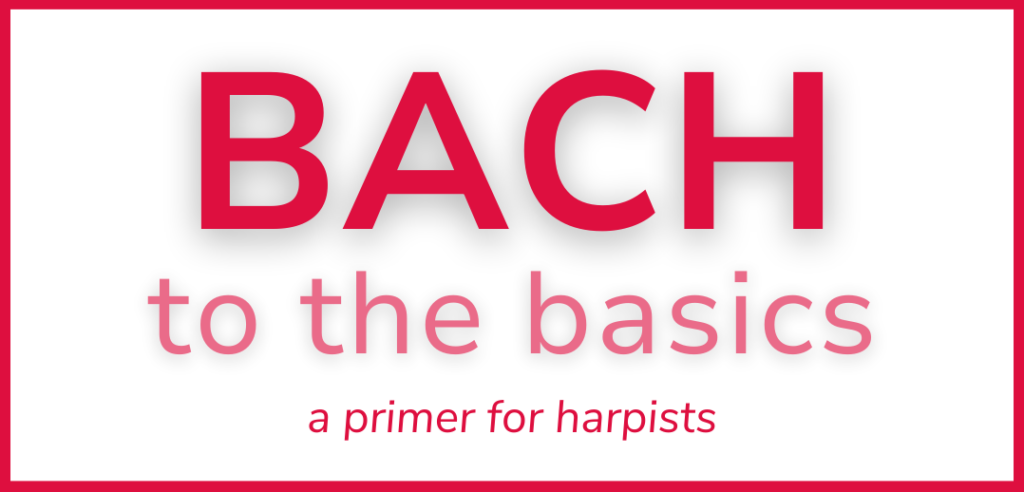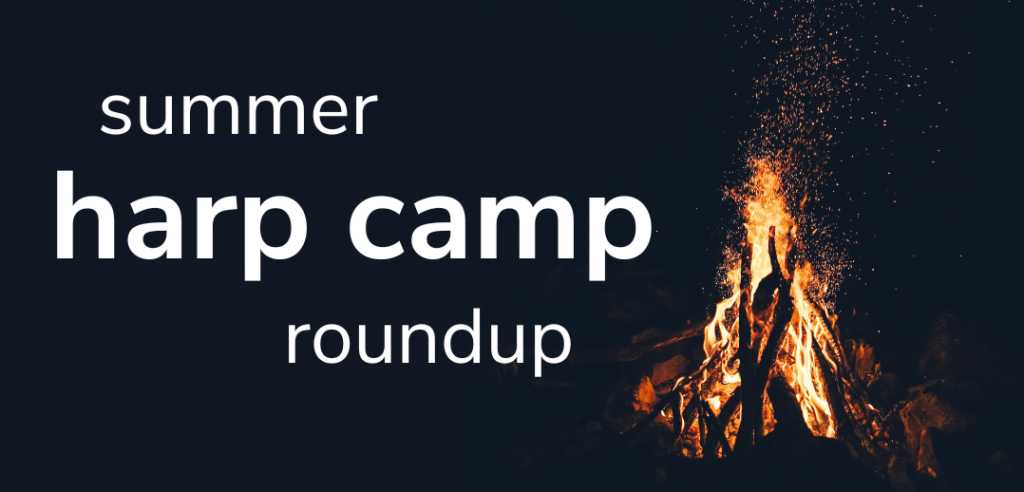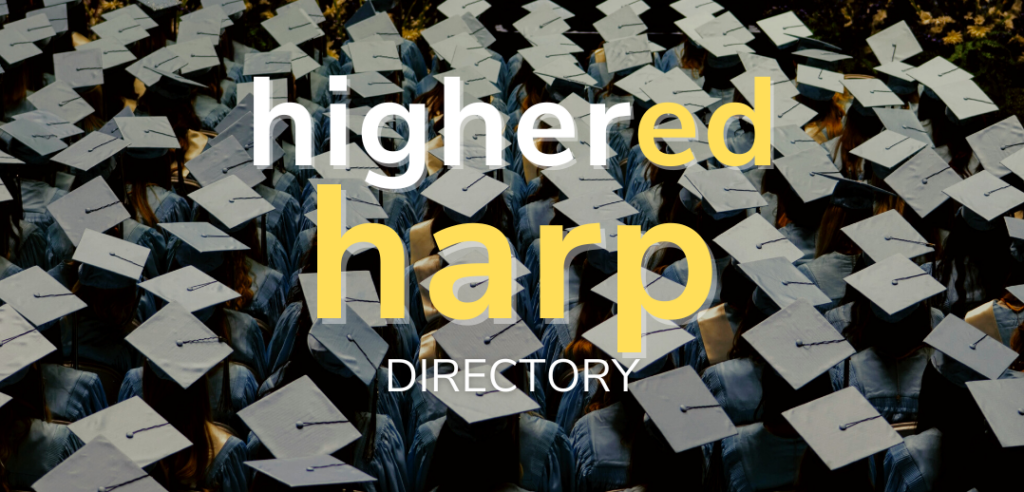Article Extras
A Teacher’s Perspective, by Kela Walton
Download this issue for a complete list of the pieces teachers love to teach. (Log in to download)
Ask any harpist about their favorite pieces to play, and they will rattle off a handful of titles and some lengthy explanations about why they love them. Ask any harp teacher about their favorite pieces to teach, and you’ll get a similar response—a short list of the pedagogical gems that hold a special place in their heart.
Indiana University harp instructor Elzbieta Szmyt believes you “play better and improve both your skills and your musicianship, if you play the pieces that you love.” So whether you are a student working on filling holes in your repertoire or a teacher brainstorming music to work on with your students this year, the eight amazing teachers we consulted have a teaching treasure or two you are sure to love. In their own words Lynne Aspnes, Jacquelyn Bartlett, Nicole Brady, Alice Giles, Jaymee Haefner, Joan Holland, Elzbieta Szmyt, and Ann Yeung (turn the page to meet them all) tell us about some of the pieces they love to teach and what makes each work worthy of a top spot on their list. While this list is by no means comprehensive, perhaps it will encourage you to revisit some old favorites, embolden you to build your harp skills with a new piece, and most importantly inspire you to love the music you teach and play.
Beginning
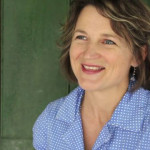
Mildred Dilling’s Old Tunes for New Harpists is a sentimental favorite of Australian harpist Alice Giles. “I started with it myself,” she says. “It was a dream to grow up to have a big harp and look as glamorous as the photo of Dilling in the front!” For beginners Giles starts with the very first page, and she likes the book’s use of third and fourth fingers early on. “I feel that helps [students] feel a round hand shape, in fact it’s easier than purely thumb and second finger. The alternating hands with stems up/down for right/left hands is easy to read; and the range is close enough and the tunes familiar enough for early/non-music readers to be able to pick it up as they go.”

The go-to beginning repertoire for University of Michigan professor emeritus Lynne Aspnes includes “works based in triad shapes which reinforce from the very start a round and fully engaged hand, and equal articulation and finger action.” She recommends Annie Challan’s “Petite Valse Pour ma Poupée” (“Little Waltz for my Doll”) and “Ping-Pong” as examples of music that follows this premise. Both Aspnes and Joan Holland, who teaches at Interlochen and the University of Michigan, also like the First-Grade Pieces for Harp collection by Marcel Grandjany and Jane Weidensaul. As Holland describes it, “The journey from a single second finger to incorporating all the fingers is smooth and simple. The pieces often have lovely harmony and voice leading, and even use of both right and left hands.”
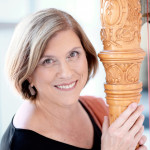
North Carolina School of the Arts teacher Jacquelyn Bartlett approaches repertoire with her beginning students by choosing “solos that tend to use the whole hand in block placing instead of single-finger notes or especially two fingers (thumb and index).” Some of her favorites for beginners are “I Hear a Harp” by Betty Paret as well as Lucian Thomson’s “Ebbing Tide” because they help students learn to place their fingers all at the same time while also teaching chord structure. “Using block placing develops the centered hand with rounded fingers more quickly,” advises Bartlett.
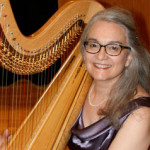
Holland also recommends Tiny Tales for Harpist Beginners vol. 1 and 2 by Carlos Salzedo to “get the beginning player advancing quickly through a variety of playing approaches from intervals to arpeggiation to melodies.” With no accidentals or key changes, the pieces are suitable for lever harp. Holland likes how these short pieces “introduce some non-traditional harmony and really challenge the harpist to try a variety of fingerings, which stretch the harpist’s learning curve.” Bartlett agrees, “all of Salzedo’s solos are carefully marked with fingerings and dynamics to develop strength and control.” In the first volume, “A Mysterious Blue Light” introduces inversions and incorporates interesting intervals and dynamics, all while reinforcing block placing and a round hand position. “Mysterious Forest,” found in the second series, utilizes placing all four fingers together as well as introduces reconnecting (or replacing). Bartlett finds these pieces and the others in the series to be valuable teaching tools. Students are not able to guess what notes or rhythms come next, she says, because Salzedo’s Tiny Tales “are creative and unique sounding and require the student to look at the printed page carefully.”
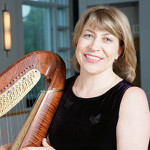
Szmyt always introduces her beginning students to the five-volume series Graded Recital Pieces by Susann McDonald and Linda Wood. In particular Szmyt loves McDonald’s “Moonlight” and “Concert Etude” in volume 1, as well as Wood’s “Processional” in volume 2 and “Russian Lullaby” in volume 3, because they “present all that is necessary to help the students develop great technical skills and cultivate musicianship.”
Both Aspnes and Szmyt enjoy teaching Nancy Gustavson’s Magic Road collection of original pieces for lever harp. Szmyt enjoys how the opening piece “A Magyar Lament” gives students an “opportunity to learn how to play legato and discover sensitive interpretation of a pure musical line.” Aspnes appreciates that “Sakura” and “Minuet” use “triadic constructions, which help to establish and secure reliable technique; are clearly constructed musically so that the student can master interpretive details; and offer a variety of musical styles.”
Playing duets in lessons or with other students is a great way to cultivate a steady pulse, solid rhythm, and counting skills. Aspnes recommends teaching duets such as “Cache Cache” by Annie Challan and later “Les Pins de Charlannes” by Henriette Renié, “that employ parallel, and predominately equal, motion in both hands, which encourages the student to develop musically as well as technically, right from the start.”
Toward the end of the beginning stages with students, both Bartlett and Szmyt enjoy teaching “The Little Fountain” by Samuel Pratt. Bartlett finds the descending 32nd note patterns to be excellent for strengthening rounded fingers, and students “learn how to play smoothly and fluidly using rhythm and accent practicing.” Szymt describes “The Little Fountain” as “one of the most beautiful and pedagogically useful pieces, and I cannot think of a better choice to teach four-finger arpeggios and lyrical phrasing.”
Early Intermediate

Fun, elaborate, and suitable for lever harp, “La Gimblette” by Bernard Andrès is a theme and variations tour de force for the early intermediate harpist. Szmyt describes the variations as excellent material for students to acuminate and refine techniques such as “trills, rolled chords, directional placing, scales, and much more.” For Holland “La Gimblette” is “very comprehensive, with each short variation demanding an excellence of playing that results in a polished work. I really like the brevity of the variations—they pack a punch and move on.”
Marcel Grandjany’s Three Easy Pieces exists in two versions: Trois petites Pièces Op. 7 published by Alphonse Leduc which has no pedal or lever changes, and Trois Pieces Faciles published by Lyra Music Company with pedal changes. University of Illinois harp teacher Ann Yeung first learned these on lever harp and then later discovered the pedal harp version. “Both versions demonstrate the possibilities of the harp in its different forms — plus how fun is it to add harmonic glissandos, change keys, and add a few more notes in a piece you know if you now have a pedal harp?” Yeung goes on to caution, “Not all might consider this work ‘easy’ as Grandjany titled it.” These charming pieces are filled with colors, character, and challenges.
Ready to hone your pedaling skills? Do you love glissandos? Szmyt thinks “Great Day” from Sparklers by Nancy Gustavson “is the best piece to teach simultaneously different types of glissandos, rhythm, and pedal changes.” For the early intermediate harpist Bartlett considers “Fraicheur” by Salzedo a “must learn.” Bartlett describes “Fraicheur” as a beautiful sounding piece that “incorporates different, harpistic techniques and sound effects…students are challenged with the use of pedals while playing beautiful, gushing glissandos.”
Henriette Renié’s Feuillets D’Album demands the harpist “use and develop musical artistry,” says Holland. “This trio of three separate pieces can be excellent for recitals.” “Esquisse” explores left-hand melodies and sophisticated bass clef muffling; “Danse d’Autrefois” reinforces equality of technique between both hands; and “Angelus” requires impeccably clean technique to achieve sostenuto bell tones. Aspnes describes the three pieces in Feuillets as “fantastic gems, benchmarks for developing skills that bring the best out of the harp.”
Intermediate
The Pozzoli Studi de Media Difficoltà per Arpa is Szmyt’s “favorite book of etudes for the intermediate level of harp playing.” Aspnes agrees, “Once the student has a fundamental command of their technique and of the instrument itself, I love the Pozzoli for their musicality and equal emphasis on developing technically in the left hand.” Szmyt describes the etudes as “musically very appealing” and her particular favorites include Etudes no. 1 for arpeggios, no. 18 for right hand octaves, and no. 21 for speed and clean finger replacement.
Each of the 15 etudes at the end of [Method for the Harp] is a musical gem, focusing on a specific technical accomplishment in well-developed musical ways.
Both Bartlett and Szmyt agree Handel’s Passacaille builds technical prowess and is an important work for students to learn. Szmyt says that this theme and variations will “challenge the student technically and help them discover how to perform Baroque music.” It incorporates a variety of skills, textures, and compositional techniques. Bartlett calls the Passacaille a “crowd pleaser.” “The rolled chords, melodies in the bass as well as in the treble, ornamentation, scales, and arpeggios are exciting to play,” she says.
The Minstrel’s Adieu to His Native Land by John Thomas is another piece that Szmyt thinks every harpist should learn. She describes it as “one of the treasures of Romantic music for harp.” The beautiful theme is followed by four variations that incorporate techniques such as crossing, thumb slides, harmonics, oscillating, voicing, and fast arpeggios. Giles also loves to teach Minstrel’s Adieu because “it is a good one for going through one-handed and two-handed arpeggios, harmonics, and dynamic control with a useful little audience piece. This was my party piece when I was young, and I auditioned for the music high school with it.”
“The Salzedo Preludes Intimes knock me out, totally.” says Aspnes, and with names like “tenderly emoted” and “profoundly peaceful” it is hard not to fall in love with these five preludes for pedal harp. Aspnes describes the Preludes Intimes as “brilliantly conceived miniatures, with the emphasis on developing exceptionally long musical lines, and very subtle phrasing. They demand tremendous attention to technical detail to create and sustain impeccably clean and clear playing, and they are hauntingly beautiful, as well as being fantastic preparation to the 15 technical studies in the Method for the Harp.”
Many teachers love teaching the etudes from the Lucile Lawrence and Carlos Salzedo Method for the Harp. Many of Salzedo’s works are beloved by Bartlett because she studied them with Salzedo, and she describes “Chanson dans la nuit” in particular as, “a pillar in the harp repertoire.” According to Szmyt, “Learning “Chanson dans la nuit” greatly contributes to development of student’s rhythmic skills and facility of pedal changes.” Giles appreciates teaching the piece for how students learn to move efficiently between effects and control many different aspects of playing—color, range of glissandi, rhythm. “The student needs to be observant of the notation and composer’s wishes and then see how [“Chanson”] results in a great little piece useful for a lifetime.” Aspnes notes, “The Salzedo Method for the Harp is about the only staple in my teaching studio. Each of the 15 etudes at the end of the book is a musical gem, focusing on a specific technical accomplishment in well-developed musical ways. If one actually learns all 15 etudes, they will be immersed in Salzedo’s compositional language, making the final four etudes, “Cortege,” “Fanfare,” “La Désirade,” and “Chanson dans la nuit” true concert studies.”
Advanced intermediate
For musical development at the later intermediate level Giles recommends Debussy’s prelude “La Fille aux Cheveux de Lin” (“The Maid with the Flaxen Hair”). “I feel it has maximum musical value for the technical level required,” she says. “The student can work on legato line with one of the most beautiful pieces by a great composer, giving insight for the colors and sensitivity they will need for the Debussy Sonata and other similar repertoire pieces in the future. I still use this piece as an encore myself—its quiet simplicity is so welcome to performer and audience alike at the end of a busy recital.” Joan Holland agrees that studying works such as “First Arabesque,” “En Bateau,” and “Claire de Lune” by Debussy are crucial for harpists poised to make the leap to advanced playing. “I think that often a harpist may think they are not such serious works, because they are somewhat short, but they are gems and have seemingly endless windows of learning and expressiveness. I always teach these before having a player start the Debussy Danses ssacrée et profane.”
Holland and Giles also agree that the Sonata in C Minor by Sophia Dussek is a much needed addition to the harp student’s repertoire. Holland reasons, “Every musician grows rhythmically with the study of the Classical era. Musically, they are asked to be full of life but within a framework of refinement and a stylistic steadiness. The technical aspects require clarity, articulation, and often a sweet resonance. These are all such great teaching tools.” Giles describes the Sonata in C Minor as “musically satisfying and written for maximum musical effect for the technical difficulty involved.”
The Handel Prelude and Toccata transcribed by Grandjany is another work that Joan Holland recommends harpists “sink their teeth into.” Brigham Young University harp teacher Nicole Brady especially loves working with students on the Prelude. “The harp is a unique instrument in that the resonance we create allows us to surround ourselves with the sound we create. The big, changing chords at the opening provide a wonderful opportunity to teach students to listen to themselves and the great sound they are filling the space around them with and how that sound changes from chord to chord. Then take those chords through new arpeggiated settings and such and when a student really listens to that world of sound they are creating, the piece is magic.”
After studying the etudes in Method for the Harp, Aspnes finds intermediate students are prepared for, “the benchmark harp concert etude, Marcel Tournier’s Etude de Concert, Au Matin.” Szymt agrees Au Matin is “a treasure” in the genre of romantic music for harp. Once students can play Au Matin Aspnes says, “The world should be their oyster, if all has gone well!”
Advanced
For advanced students Alice Giles thinks Hindemith’s Sonate is a must. She explains, “It’s one of the best pieces ever written for the harp both instrumentally and musically. Because it’s so well-written for the instrument it is well within reach for a serious student. They can work on many different technical aspects—chords, tone control, facility, strength, legato lines, clean playing, tonal colors—and expect to achieve progress every time as there is nothing awkward or frustrating. The musical development it offers is never-ending. It is all solid worth, and there is more there than a lifetime of playing can exhaust. It is encouraging and inspiring for a student to encounter this level of musical sophistication on the harp.”
Giles agrees with University of North Texas harp teacher Jaymee Haefner that every advanced student must also learn Ravel’s Introduction et Allegro. A work that almost defies genre categorization, the Ravel can be performed as a chamber work, a concerto, solo with piano accompaniment, or even as a harp duet. Haefner observes, “Each time I’ve performed this work, I find more melodic relationships between the sections, so it continues to evolve for me as I teach it in lessons as well. Like a stone that changes color according to the light surrounding it, this is a piece which takes on different characteristics with each harpist, but is still quintessentially Ravel.” The Introduction et Allegro develops from two distinct melodies. Haefner has been in love with this piece since the first time she heard Nancy Allen’s famous recording and postulates, “Ravel’s genius shows through his re-creation of these melodies as the piece progresses. Although the musical material continues to develop, the two melodies are always familiar. I believe this is the ‘hook’ which continues to bring us back to this masterwork.”
Salzedo’s concert etudes, or five “Poetical Studies” as he calls them, in Modern Study of the Harp, is another favorite teaching collection. “They definitely challenge a harpist’s technical development, while also expanding their contemporary musical language,” says Holland. Giles has all of her intermediate or early advanced-stage harpists learn Salzedo’s “Flight”, but at an extremely slow tempo to consolidate hand shape, focused strength and control, with the potential to use again later at the higher advanced level for facility and stamina. “I did the same as a student—learning the notes slowly as a high school student and then spending an enormous amount of time in college level—probably an hour a day for one year! It was foundational for my technique. I do love that it deals with scales in a musical way so the ear is not bored, with changing fingering groupings to develop evenness.” Holland describes “Idyllic Poem” as, “just that—idyllic and thoughtful.” Holland goes on to portray “Inquietude” as “a grand study of one-handed trilling and tremolo, with left-hand melody, again representative of its title, agitated and unsettled.” For Holland all the etudes are “indicative of their titles and push one to the next levels of facility.”
When asked about her favorite work, Aspnes replied, “If you ask any of my students I know what they would say is my own personal favorite work in our repertoire, and that would be the Britten Suite for Harp.” Aspnes finds the Britten “endlessly fascinating, always revealing some new and mysterious perspective, and a true testament to the power of Britten’s compositional abilities and deep understanding of the harp.” She elaborates that Britten’s opera parts and chamber music for harp “all require a ‘take no prisoners’ technical approach, in order to deliver the musicianship of each piece. He sacrifices nothing for the musical integrity of each work; his music requires nothing less than perfection from the harpist, and for these reasons I find the Suite for Harp endlessly satisfying to prepare, and to perform.”
Interestingly, though perhaps not surprisingly, the piece most recommended by our expert teachers is Salzedo’s Variations sur un thème dans le style ancien (Variations on a Theme in Ancient Style). Szmyt loves to teach the Variations to students in their “advanced harp life,” and Alice Giles also recommends it “because it’s also a great technical study.” Nicole Brady enjoys performing and teaching the Salzedo Variations because it “covers all main-stream technical demands on the advanced harpist in short variations where technical skills can be honed and result in a substantial concert piece.” Joan Holland agrees, “Aside from the expansiveness of this work, and the grandeur of the theme, a technical prowess is required to get beyond the technical demands and to deliver the many stories each variation tells. I find that a true commitment from the student is necessary to have a satisfactory experience for both performer and listener.”
According to Aspnes, “The Salzedo Variations on a Theme in the Ancient Style never seems to get old (bad pun, but true!) and I find that many students revel in practicing this muscular and worthy piece. There is enormous stylistic history embedded in each variation and, combined with the technical mastery that comes from working on this piece, students can develop a connection to numerous historical styles that will carry over into their collaborative, orchestral, and concerto playing in very meaningful ways.” Aspnes continues, “The Variations is a key advanced work from our repertoire that I enjoy playing myself and hope my students enjoy learning.” Aspnes need not wonder if she successfully imparts mastery and conveys joy to her students. Nicole Brady tells about how she studied this piece with Lynne Aspnes, “She was so good at helping me digest the music in an organized way that made learning and performing the piece so much easier. I love teaching it because it can be worked on a little bit at a time to perfect technique while learning other repertoire. It is also very fun to play, and I love teaching the stories behind each variation and encouraging my students to bring it to life.”
Finding the right pet
“[Choosing repertoire] is about finding inroads to engage the student’s sense of mastery,” Aspnes points out. Hopefully these pieces will inspire teachers and students to experiment with new musical ideas, develop technical skills, and explore the capabilities of the instrument. As Szmyt puts it, “I strongly believe that all harpists should have in their repertoire and include in their performances pieces that showcase their own technical and musical abilities as well as the technical and sound possibilities of the harp.” •
Kela Walton is a professional freelance performer and teacher based in Buffalo, N.Y.






